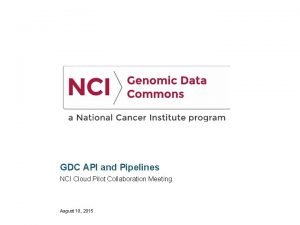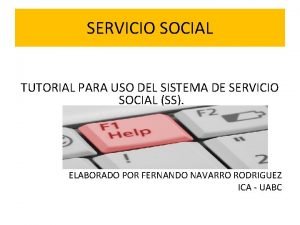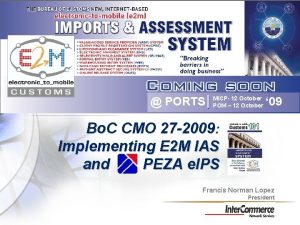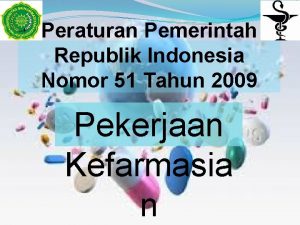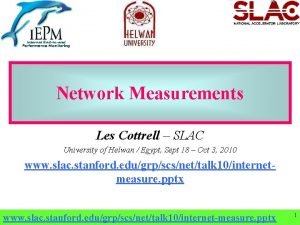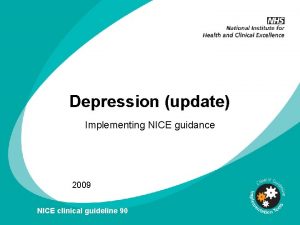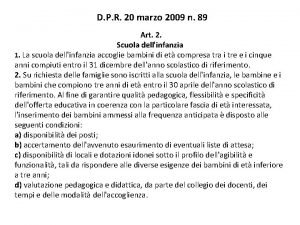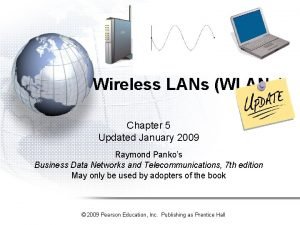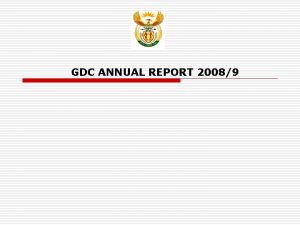GDC Europe 2009 What Is a Living Plan























































- Slides: 55

GDC Europe 2009 What Is a Living Plan and How Can We Achieve It? Dorian Kieken Development Director Bio. Ware


How do you plan that? Short answer: you don’t! Long answer: everyone does

Video game planning challenges The fun factor No magical formula. Always the result of iterations Cannot be measured Regular changes of priorities

Video game planning challenges Evolving Technology Constant readapting Organization diversity One unique methodology rarely works well Information gathering Vast amount Time consuming and painful to gather

Video game planning challenges

What is a living plan?

What is a living plan? Organized the way you are Flexible Allows major changes along the way

What is a living plan? Constantly up-to-date Reflects reality Matches what people do on the team

What is a living plan? Everyone is aware of the plan Team members collaborate through the plan Shared

What is a living plan? No single plan owner Everyone owns and contributes to the plan “Bottom to top”

What is a living plan? Flexible Shared Reflects reality “Bottom to top”

How to achieve a living plan? Project Management Technology Team

How to achieve a living plan? Project Management Technology Team

What are we trying to achieve? Autonomy Empowering “Bottom to top” Ownership Schedule Awareness

The Team Culture The Culture is defined by its people It’s pretty difficult to determine where a culture comes from

Starting with the visible Perception is reality Small visible actions can have more effect than larger ones that are less visible

The Broken windows theory

Broken windows in games Family, Humility, Support

An other approach: Agile Methods Team Empowering culture Agile/ Scrum methodologies

What is Scrum? Originates from software development Set of practices and predefined roles

Scrum: Objective based teams The Scrum Team Self-organized group oriented towards an objective Scrum Team: 3 to 10 persons Ex: the Combat Scrum Team The User Stories Customer Requirement Acceptance criteria's (and acceptance tests) Outcome: Focus on the big pictures

Scrum: Self-Organization Self Organized meetings Daily 10 min stand-ups Sprint Planning/Reviews Sprint Retrospectives Interaction between the team Priority: unblock others Scrum Master is a facilitator Outcome: Autonomy, Schedule Awareness

Scrum: Pitfalls Imposed change Usually never works or works badly Need to come from the team Find an evangelizer Start small, spread The “Silo mentality” Lack of communication between Scrum Teams Importance to have a project communication structure (scrum of scrums, roundtables, etc…) Project objectives over scrum team ones

Summary of the team approach Goal “Bottom to top” Tools Broken Windows Agile/Scrum Result Self-Organized Autonomous

How to achieve a living plan? Project Management Technology Team

What are we trying to achieve? Can reflect any team organization Real-time data Collaborative Workspace

The Project Management Tool Three key components On-line Liked by your team Shareable Centralize data in one place Don’t force a tool that people don’t like Flexible The tool should not force you to change the way you’re organized

Example: an Art Workflow Illustration Model Rig Texture Animation Lighting pass

Example: an Art Workflow

Example: a Programming Workflow User Story Task 1 Task 2 Task 3 1 st Iteration Test/Feedback 2 nd Iteration Test/Feedback

Example: a Programming Workflow

Collaborative workspace

A tool at the center of the pipeline What Design/Requirements Result Source Control Reference Update How Building Backlog Naming Convention Project Management Tool

A tool of communication User Stories discussion, logs Validation, on-demand testing

On-line tool: Pitfalls Tool collaboration/communication should NOT replace face to face communication! A tool not regularly updated becomes useless People stop checking/using it because data is not up to date Broken Windows issue

Tips on updating the tool Update the tool daily! Any update that can be automated should be automated Setup clear update moments until it becomes a strong habit in your team. Ex: before every stand-up, every night, etc… A simple update usually takes less than 1 min if it takes more, ask yourself if you have the right tool

Summary of the tech approach Tool Result On-line Shared Liked by your team Reflects reality Flexible Can reflect any team organization

How to achieve a living plan? Project Management Technology Team

What are we trying to achieve? Constantly balancing the game scope Quality/Content Time Cost/Resources

Control is an illusion You can’t control what you can’t measure Too many variables & changes have to be taken into account A thorough plan does not mean more accuracy. Creates a “false” sense of security. Hofstadter’s Law: “It always takes longer than you expect, even when you take into account Hofstadter's Law. ”

Guide versus Control Not having control doesn’t mean you don’t have an influence The role of a guide Two major tools to guide Knowing: interpreting data Anticipating: managing scenarios

Interpreting data

Interpreting data: Burndown charts Burndown chart = work left to do versus time

Interpreting data: Burndown charts Work hours added Work removed Unplanned worked Training

Interpreting data: Meta-Data What is Meta-Data search? Ex: Google search with multiple operators (+, “”, -, etc…) Why? Allows to read data from multiple angles Essential for big projects (ex: Mass Effect 2 has currently 13 000 user stories or tasks)

Interpreting data: Meta-Data

Managing Scenarios Anticipation versus Reaction

Managing Scenarios Multiple scenarios at multiple levels: Micro: Scrum Team Macro: Project Prioritize scenarios by risks/probability Put systems in place that allows you to make/change scenarios easily

Examples of scenarios

Project Management pitfalls Never rely on data alone Same data can be presented in different ways Data needs to be coupled with other elements to provide good information Other source of data Context Even intuition Never fall in love with a scenario or specific plan. There are too many changes that can happen. Plan F is sometimes the best and most viable plan

Summary of the PM approach Goal A balanced scope Tools Result Data interpretation More anticipation Less reaction A detached perspective Scenario management

Final words Project Management Technology Team

Final words

Thanks for listening! Questions? Contact info Dorian Kieken dorian@bioware. com Some references On Broken Windows: The Tipping Point by Malcom Gladwell (book) On Scrum: Advanced Scrum and Agile Development by Clinton Keith (lecture) On the illusion of control: Any Idea Whose Time has Come and Gone? by Tom De. Marco
 Gdc api
Gdc api Gdc arki
Gdc arki Pdp template gdc
Pdp template gdc Gdcuk
Gdcuk Ssssdddd.yt rinex file format
Ssssdddd.yt rinex file format Nct01328626
Nct01328626 Mick gordon gdc
Mick gordon gdc Pyramid hesd
Pyramid hesd Shell living or nonliving
Shell living or nonliving Living non living dead
Living non living dead Smallest living unit
Smallest living unit Plan nacional del buen vivir 2009 al 2013
Plan nacional del buen vivir 2009 al 2013 Affiche propagande guerre froide
Affiche propagande guerre froide Indian independence lesson plan
Indian independence lesson plan Chapter 23 section 5 the congress of vienna pdf
Chapter 23 section 5 the congress of vienna pdf Forever living business presentation
Forever living business presentation Living well strategic plan
Living well strategic plan 2008-2009 school year
2008-2009 school year 2009 mathematics standards of learning answers
2009 mathematics standards of learning answers Siss uabc
Siss uabc Uma máquina fotográfica custava r$ 400
Uma máquina fotográfica custava r$ 400 Legible meaning
Legible meaning Cais.ecustoms
Cais.ecustoms Permenkes 51 tahun 2009
Permenkes 51 tahun 2009 R.t.t. 2009
R.t.t. 2009 January 2006 chemistry regents answers
January 2006 chemistry regents answers Institutional calendar
Institutional calendar What is rcfce act 2009
What is rcfce act 2009 Impaact 2009
Impaact 2009 In 2009 there were 1570 bears
In 2009 there were 1570 bears Rosa catania 2009
Rosa catania 2009 Calendario escolar 2009 a 2010 sep
Calendario escolar 2009 a 2010 sep Nice 2009
Nice 2009 Decreto 1290 de 2009
Decreto 1290 de 2009 Dpr 89/2009
Dpr 89/2009 Microsoft word 2009
Microsoft word 2009 2009 pearson education inc
2009 pearson education inc 2009 delmar cengage learning
2009 delmar cengage learning 2009 delmar cengage learning
2009 delmar cengage learning Introduction to medical terminology chapter 1 answer key
Introduction to medical terminology chapter 1 answer key Iso 9004 2009
Iso 9004 2009 Analisis perubahan laba kotor
Analisis perubahan laba kotor Sunny's adventure 2009
Sunny's adventure 2009 Wonnacott discrepancy matrix
Wonnacott discrepancy matrix 7 adar nedir
7 adar nedir 2009 pearson education inc
2009 pearson education inc 2009 pearson education inc
2009 pearson education inc Mhs dress code
Mhs dress code Write recommendations of yeshpal committee
Write recommendations of yeshpal committee Pearson 2009
Pearson 2009 2009 delmar cengage learning
2009 delmar cengage learning Uu no 41 tahun 2009
Uu no 41 tahun 2009 Toyota public relations crisis
Toyota public relations crisis Modu code 2009
Modu code 2009 Battle of yorktown webquest answer key
Battle of yorktown webquest answer key Scuola media concorezzo
Scuola media concorezzo
